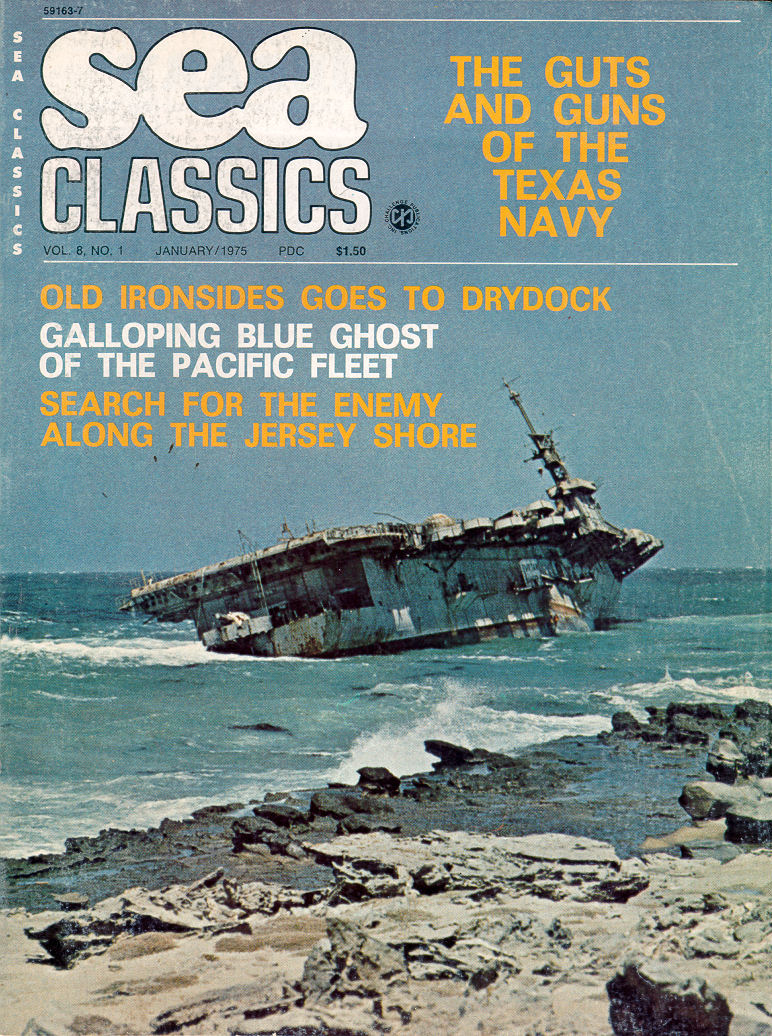

 |
|||
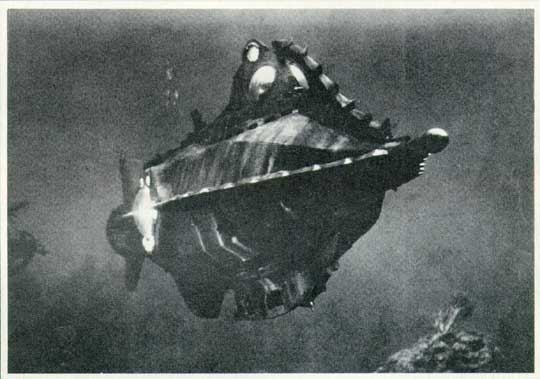 |
|||
 |
ULES VERNE, first of the great, popular science fic- tion writers, startled readers around the world when, in |
there were no complete plans or even drawings of Verne's visionary craft. Early on, Disney seemed to be in favor of a cigar shaped, space |
|
|
1870, he published his novel
"20,000 Leagues Under the Sea." The most exciting of Verne's stories was also to become one of the classic all time adventure films brought to the screen by the genius of Walt Disney and his talented staff. As with all major motion picture efforts, work began long months be- fore any shooting took place. A year of pre-production planning was car- ried out on the film that other giant motion picture studios had deemed impossible. The biggest attraction and the big- gest headache for the film makers was the Nautilus herself. Jules Verne's word was law as far as production was concerned and his description of the submarine was to be as closely followed as possible in the film. The problem was that |
ship-like affair, but Harper
Goff, the man to whom most of the credit for the movie should really have fallen, fought to keep the design of the ship on a believable basis for the period in which the story was to take place, the world of the 1870s. Captain Nemo wanted his vessel to give the appearance of a terrible sea monster when it attacked ships at sea, and this feature had to be built into the design. This would in- clude primarily the great bulging eyes, the dorsal fin and the giant tail. Again, much of what was finally used in production was the result of Mr. Goff's brainstorming although most of the credit was given to the production manager, Mr. Fred Leahy. Indeed, he received an Academy Award for the special effects in the movie. |
| "20,000 Leagues Under The Sea" Photos copyright Walt Disney Productions |
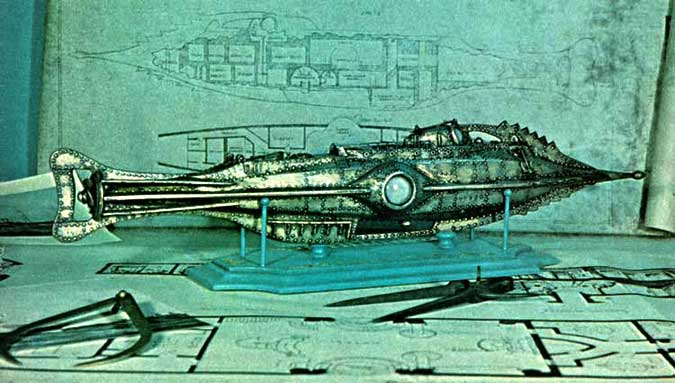 1 3 |
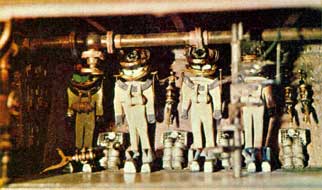 2
|
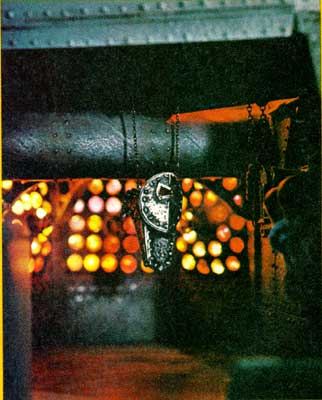 |
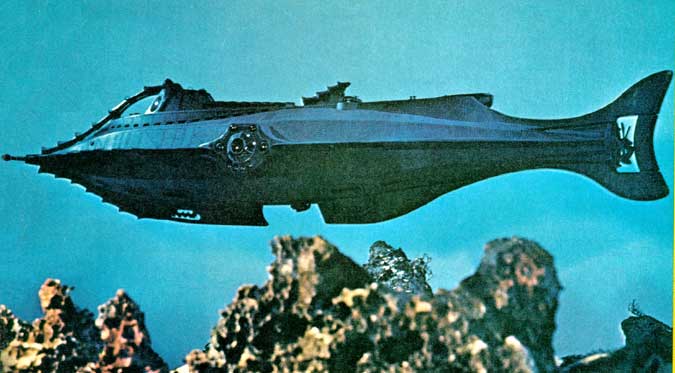 4 |
|
1 Below the Chart Room lies the Outtitting Room where the crew suited up in their diving gear. 2 The Wheelhouse--where the submarine was steered by looking through the view- ing ports at each side of the wheel. Other features include the diving control stancions to the left of the wheel. Along the wall is the atomic counter and trim indicator. 3 |
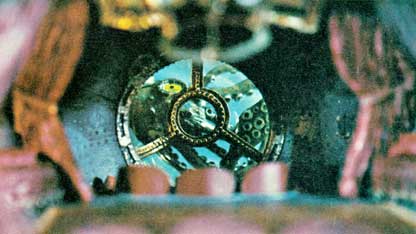 |
| Captain Nemo
had discovered what man- kind has always sought--the veritable dynamic power of the universe. 4 Through the starboard viewing port is the giant squid, which attacked the NAU- TILUS with its 30-toot tentacles and almost killed Captain Nemo. |
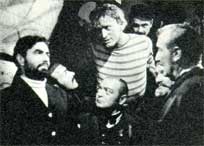 |
The
gentlemen shown here need no
|
| 1 |
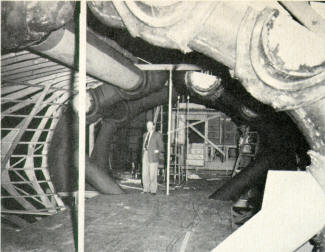 |
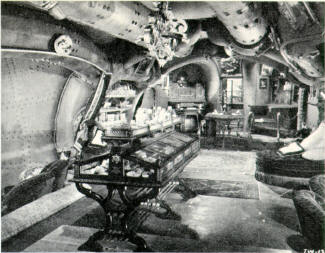 |
2 |
| 3 |
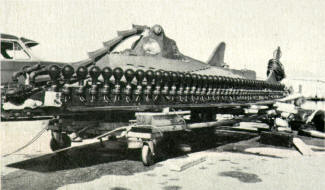 |
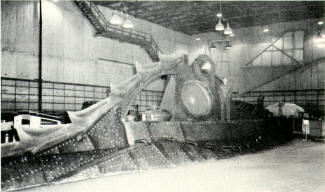 |
4 |
| 1
2 The interior of the NAUTILUS was one of the finest examples of Hollywood magic ever created. Here, in the uncompleted set for Captain Nemo's salon, stands designer Harper Goff. The accompanying photo shows the same view only after the set has been completed. The L.A. area was scoured for antiques that would blend in well with the set design. As can be seen from the photo of the unfinished set, the movie was faithful to a popular building technique of the era in which giant tubes were used to form the framework for the sub. These tubes, in addition~to providing structural strength, were alternately filled with air or water as a means for ballasting the sub. Again, this was all Mr. Goff's brainchild. 3 Several versions of the NAUTILUS were built for the movie--and in several sizes. Overall shots where the entire sub would be in view were done in a specially constructed 90x165-foot tank inside a sound stage using a brass 12-foot model, the same model Shown in the lead photo of this article and the same model which for many years sat on display at the "20,000 Leagues Under the Sea" exhibit in Disneyland. The unit in this photo was only a surface model of about 20 feet total length and was used for all of the surface running shots which were filmed |
in the large outdoor tank at the old 20th Century-Fox facility in Studio City, California. The lights created an eerie glowing effect around the ship as she charged at "collision speed" to saw her victims in half. 4 The third model built of the NAUTILUS was really a full scale mock up of the above-waterline section. This was constructed for the scenes in which actors would be seen on deck. This unit was also placed in the Fox tank for shooting. 5 One of the action highlights of the movie comes when the NAUTILUS is attacked by a giant squid. More than $200,000 and eight shooting days were required to bring this sequence to life. Research indicated that squids have been known to possess tentacles 90 feet long and weigh in excess of 20 tons. The sea beast created for the Disney epic sported only a 40 foot reach! Weighing two tons, the Disney squid was a masterpiece of rubber, spring steel, flexible tubing, glass cloth, lucite and other forrns of plastic. In fact, the squid was a giant marionette requiring 28 men to bring it to life. Another 100 men backstage were required to bring the entire sequence to life. Viewers will recall that the scene took place in a violent storm. |
6 This shot shows the 20-foot model on the surface of the big outside tank. Movie goers might recall the scene that is being prepared here where the NAUTILUS, with Captain Nemo in a near state of hypnosis, rams and destroys a ship carrying nitrate. Note the worker standing in the far end of the tank. 7 One of the scenes in the movie called for Nemo to leave Kirk Douglas, Peter Lorre and Paul Lukas stranded on the surface while the sub dived. It was determined that in order to obtain this particular piece of footage, special arrangements would have to be made. The purpose is obvious and the U.S. Navy was kind enough to provide the USS REDFISH for a short time in order to accomplish the desired effect. Scene was shot off San Diego using stunt men. 8 Special fully operational diving suits weighing some 225 pounds not including lead weights were designed for the underwater diving sequences which were filmed in the Bahamas. This in itself was an amazing work of art. |
| 5 | ||
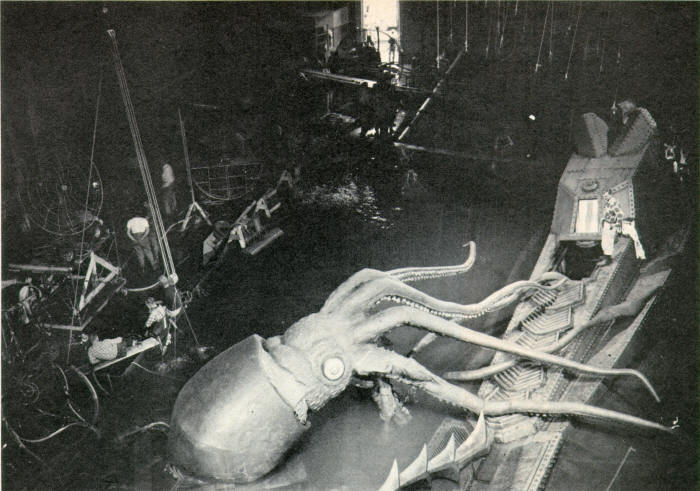 |
||
|
6 |
7 |
|
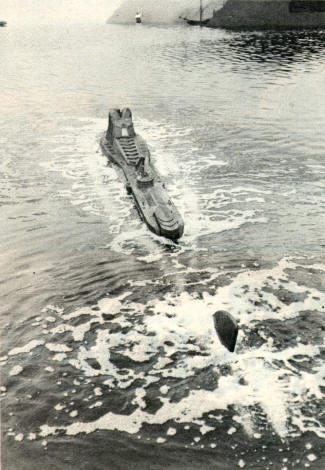
|
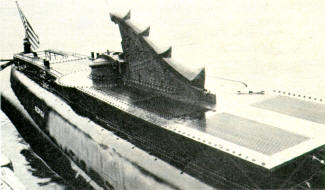 |
|
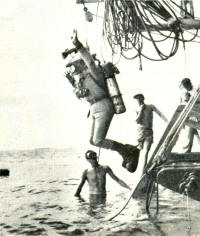 |
8
All black and white |
|